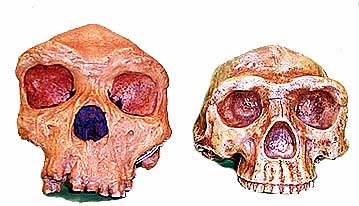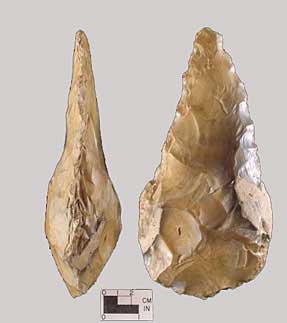

The first diaspora (scattering or dispersal of any group) started around 1.8 mya, when Homo ergaster, perhaps already evolving into Homo erectus, left Africa, entered Asia, and kept on going east. By 1.8 or 1.6 mya, Homo erectus is found in Indonesia (on the now-island of Java), and subsequently throughout eastern Asia, into northern China. Once Homo erectus evolved from the immigrating H.ergaster, (or spread there from immigrating African H.erectus) they appear to have been a very successful hominin. The youngest Homo erectus remains have recently been dated at possibly a mere 27,000 years ago, at the Java site of Ngandong. These finds may represent an isolated "hold-out" population who managed to survive long after Homo sapiens evolved and migrated into eastern Asia. If the relatively newly discovered Homo floresiensis (on the nearby island of Flores) is indeed a new species, there may have been three species of hominin in parts of southeast Asia as recently as 27,000 years ago. This may demonstrate that after the first wave of migration, parts of eastern Asia were cut off from both biological and cultural developments in Africa.
In Africa, Homo ergaster continued to evolve. By at least 800,000, a hominin now classified as Homo heidelbergensis evolved in Africa. Some populations of H. heidelbergensis again left Africa, moved into southwest Asia and eventually into Europe. There is no evidence that this hominin reached eastern Asia. In terms of culture, throughout this time period of the Lower Paleolithic, particularly from 1.5 mya to 200,000 years ago, there were several important cultural developments.

Homo heidelbergensis (left) and Homo erectus (right)
The use of fire is a "discovery" long attributed to Homo erectus in China, although not until close to 500,000 years ago. Finding indisputable evidence of fire is difficult, and recent studies of the Chinese evidence at the site of Zhoukoudian seems to indicate the ash found there was not from hearths built by people. It is often assumed that the ability of Homo to live outside tropical regions implies the use of fire, and that may still be true. However, the earliest Asian sites (in Java) are in a tropical environment, and the sites in temperate northern China are much more recent.
The latest evidence presented for early fire use comes from Africa, and at a very early age. Recent tests at Koobi Fora in Kenya seem to indicate the regular use of fire at approximately 1.6 mya (associated with H.ergaster). The evidence primarily consists of discolored areas within the site that could have been caused by fire. Some archaeologists do not agree that this is indisputable evidence of fire use. Currently, the most reliable evidence of definite fire use dates from about 790,000 ya at a site in Israel.
Of particular interest to the question of when Homo started to use fire is the fact that many believe the ability to make fire was necessary to utilize tubers or root plants, which unlike meat could not have been eaten uncooked. Since such tubers are normally gathered by women (in more recent foraging groups), fire use not only helped allow the development of larger brains and bodies, but also may have made the evolution of menopause adaptive. Female apes do not have menopause, nor for that matter do other mammals. Throughout their lives female apes are able to produce children; only human females spend a significant portion of their lives in what is called menopause. One hypothesis states that menopause is adaptive because of the significant contributions older women can make to group subsistence, particularly when free of the risk and time related to pregnancy, labor, and nursing.
A second major cultural development occurred in Africa at approximately 1.5 mya. This was the development of a new, more sophisticated tool tradition called the Achuelean. The critical tool of this tradition was the Achuelean handax, an exquisitely flaked ax-shaped tool that appears to have been hand-held rather than hafted.

An Achuelean Handaxe
The precise function of the Achuelean handax is difficult to say, though they serve admirably as butchering tools (as experimental archaeologists have demonstrated.) They could also be used for digging tubers, wood working, or a variety of other purposes. Whatever their uses, Achuelean handaxes and other tools of this tradition continued to be made for more than a million years. It is found at many sites, some associated with H. ergaster. Homo ergaster originally left Africa far too soon to be carrying Achuelean handaxes, and although the tool tradition did spread far into Asia, it was once thought it never reached eastern Asia. Various tools similar to Oldowan tools continued to be made by east Asian Homo erectus until that fossil disappeared, but in some areas of China, a bifacially flaked tool resembling a handaxe was produced by 500,000 ya. In western Asia the Achuelean tradition spread, and ultimately as Homo heidelbergensis migrated into Europe, they took handaxes with them. The pattern indicates both continued movement of ideas and probably people out of Africa into western Asia and Europe, and to some extent possibly a failure of ideas and people to move into eastern Asia for a million years or more after the first migration. The bifacial handaxes in China may also represent an independent invention to meet environmental conditions, but not the diffusion of Achuelean tradition into east Asia. (See text for more on this important tool.)
The earliest migration into Europe is probably close to the time of the oldest European site, Gran Dolina Cave in Atapuerca, Spain. The site is dated at 780,000 years ago, and although there are few tools, a handax has recently been discovered at the site. [The nearby site called Sima del Elefante (“Pit of the Elephant”) contains the earliest evidence of humans in western Europe—fragments of a jawbone and teeth date to 1.1–1.2 million years ago.] Some of the bones of the at least six individuals found at Gran Dolina site show cut marks indicated the flesh was removed from the bones, which some have interpreted as evidence of cannibalism. The fossils have been classified by their discovers as a new species, Homo antecessor, and its discoverers believe that it is ancestral to both the later Neandertals and modern Homo sapiens. Others believe that the site, and its fossils, represent a early but failed attempt to colonize Europe, and that while H.antecessor may indeed be a separate species, it rapidly became extinct. In general the evidence would see to indicate that these fossils are a form of H. heidelbergensis, and do indeed evolve, in Europe, into Homo neanderthalensis. You can view (not required) an excellent 45 minute video on this site. You may also be interested in browsing (and looking at pictures) of Gran Dolina, and you can also check out the more recent (400,000 ya) nearby site of Sima de los Huesos (Pit of Bones) on the same website (not required). The information you need to know on these sites is covered in the text.
The recently reported (July 2010) tool cache from Britain is dated at 780,000 ya; at that time Britain was a cold and heavily forested environment. No hominin remains have been recovered, though speculation is that the hominin responsible was a form evolving into Homo heidelbergensis. It is unclear if this is a refugee population that originally colonized the area when the climate was warmer, or if indeed these hominids were able to cope with the environment. The early date is consistent with an expansion into Europe as early as 1.2 mya, as indicated by Sima del Elefante in Spain.
As noted above, there is evidence that the larger-brained Homo heidelbergensis was evolving in Africa even earlier than his appearance in Europe. (Remember that the 1.2 mya hominin fragment can not be securely identified; it is likely that the earliest sites known in Africa for this fossil are not the oldest.) First identified in Europe, this species looks so much like modern humans that until the 1990's it was one of several fossils referred to as archaic Homo sapiens. The earliest definite members of this species are certainly represented by the 600,000 + year old fossils from Broken Hill, Zambia, and Bodo, Ethiopia. By 500,000 years ago, H. heidelbergensis is found in Germany, and at other sites throughout Europe. Some of the first definite shelters are found in Europe, along with definite evidence of fire, and beautifully crafted (and preserved) 6-7 foot long throwing spears (see text p. 102). Achuelean handaxes are present, but scarce in Europe until 300,000 years ago. This may indicate an almost continual migration of people and/or diffusion of ideas out of Africa. And there is no question that humans were now capable hunters (and no doubt capable gatherers).
[Note: You can again check the lesson on Phylogeny for detailed descriptions of these fossils, as well as their relationship under the Replacement hypothesis. Remember the phylogeny provides much more information about fossils than you need for this course. Also remember that your text classifies Homo ergaster as Homo erectus, whereas the lessons follow those paleoanthropolgists who think the evidence indicates two separate species, with Homo ergaster perhaps being the ancestor of both H. erectus and H. heidelbergensis.]